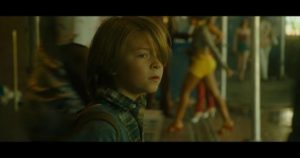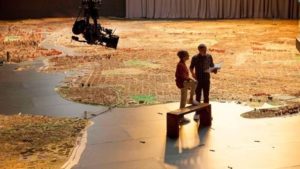
Wonderstruck, based on Brian Selznick’s book, showcases renowned Cinematographer Ed Lachman’s artfull photography of the interwoven stories of two 12-year-old deaf children from different time periods, who run away to New York City in search of what’s missing in their lives. In 1977, Ben, deaf from a recent accident, follows clues to find his father; in 1927, Rose, deaf from birth, seeks to reconnect with her mother. Ultimately, these two stories merge into a beautiful narrative that honors the imagination of children.
For Lachman, the challenge was to visually portray the thoughts and emotions of both children. Both stories are “mirrored in the use of images to depict sound.” The viewer experiences Rose’s 1927 world as a black-and-white silent film, intercut with Ben’s world in color in 1977 as he experiences life as a newly deaf person. The DP had previously worked with Director Todd Haynes on Carol, Mildred Pierce, I’m Not There, and Far From Heaven. “We looked to create the visual metaphors for deafness,” noted Lachman. “Todd does a lot of visual research, from which he creates a ‘look book’ that illustrates his ideas including the politics, history, demographics, art and cinematic language of the time periods. He makes the world so specific in its details that you feel you’re present in the moment, rather than in a romanticized, clichéd stylization of it.” Indeed, the look book creates the emotional structure of the film.

The Golden ‘20’s, before the Great Depression, was a period of optimism and prosperity. In the 1970’s, New York City was in economic decline and physical deterioration. For the 1977 story, they referred to the “dystopian films of the ‘70’s” for inspiration, including Midnight Cowboy, Mean Streets, The Conversation and The French Connection. Lachman shot the black-and-white footage with his vintage Cooke Speed Panchro lenses, which sometimes created a “halation around highlights.” To emulate the lighting of the 1920’s, he lit with mostly tungsten Fresnel lamps, creating harder direct light. The Museum of Natural History in New York City made an exception, because they admired Brian Selznick’s book, and allowed the team to shoot there – with many limitations.
“We were only allowed to shoot at night and had to load in at 6:00p.m. then load out everything in the morning each day.” These constraints led them to shoot all the museum sequences (color and black-and-white) with the Arri Alexa Mini rated at 1280 and recording ProRes 4:2:2. In order to match the black-and white digital footage with the Double-X, they applied LiveGrain texture in post production, which is unique because it “tracks the highlights and shadows, making the grain smaller in the highlights and larger in the shadows,” approximating the look of film stock.
Since Ben is newly deaf in the 1977 story, the filmmakers “removed the audience from the objective experience of the hearing world, by using handheld and floating shots to create the boy’s subjectivity in his urban environment.” They shot handheld on the streets from either a Western dolly or wheelchair, often over-cranking. Lachman’s lens choices were his older Cooke 20-100mm and 25-250mm zooms.
To emulate the gritty realism of late ‘60’s and early ‘70’s films, Lachman chose Kodak Vision3 500T 5219 and 250D 5207 pushed 1-stop. As a radical departure from the standard, they “used tungsten outside with the 85C, or with no 85, and 250D on interiors, partially correcting the color in post, which gave it a different color quality.”
Lachman, who began his journey in art school, was always “interested in how you could use color as a thematic in storytelling as a psychological tool.” The scene when Ben arrives by bus at New York’s Port Authority was shot in an ex-cruise line terminal using a mixture of Cool White fluorescent tubes with Lee 104 Deep Amber gel in practical fixtures, “which created a dinginess” that looked like the mixed color temperatures (cyans and yellows) of the 1970’s Port Authority.

All the miniatures, except for Rose’s cardboard buildings were shot with the Alexa Mini. Lachman also worked with DP Ivan Abel and his long time gaffer John DeBlau, to help match the lighting between the first unit photography and miniature sets. The live action miniature “puppets” controlled with strings and rollers, allowed them to shoot everything in camera, without the use of digital animation.
In Wonderstruck, Ed Lachman humbly asserts that Todd Haynes has “honored the imagination and resourcefulness of children showing their language of communication, be it through hearing or deafness… I know my images would not have been the same without the valued collaboration with Haynes, production designer Mark Friedberg, costume designer Sandy Powell, editor Alfonzo Gonzales, composer Carter Burwell and my crew.”





